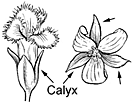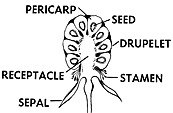Juniper Berry
Citharexylum caudatum
Verbena family (Verbenaceae)
Post-Cook introduction
This shrub or small tree introduced as an ornamental has become naturalized locally. It has paired elliptical leaves and narrow clusters of small slightly fragrant white flowers, and showy shiny pear-shaped or elliptical that turn from green to orange, brown or black.

Forest And Kim Starr
Leaves hairless, on leaf-stalks of 3⁄8–3⁄4 inch (1–2 ). Blades elliptical, 2–5 inches (5–13 ) long and 3⁄4–2 1⁄4 inches (2–6 ) wide, blunt to short-pointed at and short-pointed at base, with edges sometimes slightly turned under, slightly thickened, with few side veins, slightly shiny green above, and beneath dull and paler with many tiny dots visible under a lens. leaf-stalks and midveins often orange red.
Flower clusters () 1 1⁄2–6 inches (4–15 ) long, and lateral, narrow and unbranched. Flowers are many, on short stalks of 1⁄16 inch (1.5 ), about 5⁄16 inch (8 ) long and broad. bell-shaped, 1⁄8 inch (3 ) long and broad, minutely five- the white finely hairy with tube nearly 1⁄4 inch (6 ) long and five spreading slightly unequal rounded 1⁄8 inch (3 ) long; 4 small inserted in tube; and greenish 3⁄16 inch (5 ) long with two-celled slender and slightly two-
() in drooping clusters, nearly 1⁄2 inch (13 ) long, slightly two- fleshy, with remaining at base, containing two elliptical shiny brown nutlets 3⁄8 inch (10 ) long, each single-seeded.
The light brown hardwood is used elsewhere for posts, not for musical instruments, as reported. This species is a honey plant.
An introduced ornamental in Hawaii, it is a common street tree in Honolulu. When young, highly susceptible to wind damage. Naturalized locally, for example, in wet forests at 2000 ft (610 ) altitude on Oahu.
Range
Native of West Indies from Bahamas to Jamaica, Puerto Rico, and Dominica. Also from Yucatan, Mexico, and Central America to Colombia. Planted in southern Florida
Other common names
fiddlewood; pendula de sierra (Puerto Rico)
This species is reported to be one of the many hosts of the black twig-borer, a major insect pest.
The generic name Citharexylum is Greek for fiddlewood. The English name fiddlewood and similar ones in French and Spanish for related species apparently were taken from the scientific name without regard to actual use of the wood.








